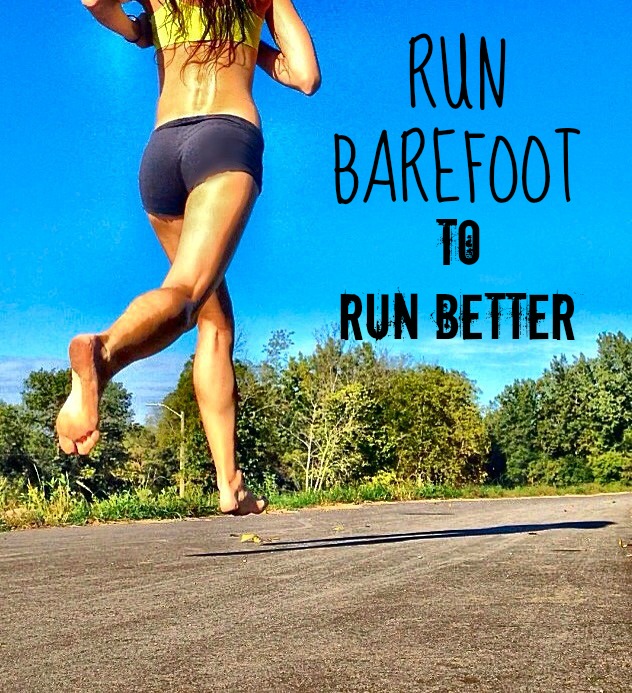Another great reason to run barefoot is that barefoot running enhances coordination of motor patterns, thereby improving movement efficiency, allowing the runner to run for longer periods of time.

Run Barefoot to Run Better
Ever wonder why Ethiopian runners like Tirunesh Dibaba and Haile Gebrselassie run so smooth? It’s because they ran barefoot for many years as children, allowing them to be more biomechanically adjusted as adults.
Why Barfooting is Best
During running, maximal responsiveness of proper leg movements and forefoot strike development are induced by sending tactile stimulation through the plantar surface. Barefoot running appears to help us develop strong limb mechanics, especially when running at faster speeds and on rough terrain where greater stability is required. How does barefoot running make this possible?
Studies lend support to the idea that barefoot running leads to enhanced proprioception, thereby enhancing flexibility in response to unexpected perturbations and reducing impulsive leg displacements (Sponberg and Full, 2008; Proctor and Holmes, 2010; Proctor et al., 2010).
Most essential, the proprioceptive feedback during barefoot running constructs motor commands that are tightly coordinated and patterns stable and efficient motor activities, suggesting that barefoot running strengthens the coupling between proprioception and the central pattern generators in the spinal cord. Therefore, barefoot running leads to consolidation of adequate movement skills that are already hardwired.
Cushioned Running Shoes Reduces Sensory-Motor Precision
In most cases, shod-joggers move unproductively because their cushioned footwear depresses repetitive sensory input needed to generate stable, ongoing motor patterns. Earlier work has found that properties of substrates, such as cushioned running shoes, with which the legs interact, drastically changes local information (proprioception) about leg states and positions and therefore, affects movement coordination (Fuchs et al. 2012).
Indeed, a runner does not become mechanically competent via running shoes reducing sensory feedback. This is because running shoes disrupts motor coordination that only proprioception can modify.
The take home message is that our leg mechanics seem to advance to the next level when we run barefoot and the fact that evidence indicates that barefoot running is evolutionarily quite ancient should tell us something. Evidently, runners in barefoot like running shoes engage in normal biomechanics (i.e. forefoot running), which suggests that a thin rubber sole without padding provides a rich exposure to sensory input similar to barefoot running.
Always remember barefoot = Learning properly how to run and enhances performance and overall tissue, joint and bone health.
More From Run Forefoot:
- Top Barefoot Shoe Brands
- How Forefoot Running is Safer for Achilles Tendon
- Zero Drop Minimalist Shoes Ease Hip Pain
- Why Every Forefoot Runner Should Have a Wobble Board
- Barefoot Running Improves Ankle and Knee Stability
References:
Fuchs et al. Proprioceptive feedback reinforces centrally generated stepping patterns in the cockroach. J Exp Bio, 2012; 215:1884-1891.
Holmes, P., Full, R. J., Koditschek, D. E. and Guckenheimer, J. (2006). The dynamics of legged locomotion: models, analyses and challenges. SIAM Rev. 48, 207-304.
Jindrich, D. L. and Full, R. J. (2002). Dynamic stabilization of rapid hexapedal locomotion. J. Exp. Biol. 205, 2803-2823.
Kukillaya, R. P. and Holmes, P. (2007). A hexapedal jointed-leg model for insect locomotion in the horizontal plane. Biol. Cybern. 97, 379-395.
Kukillaya, R. P., Proctor, J. and Holmes, P. (2009). Neuro-mechanical models for insect locomotion: stability, maneuverability, and proprioceptive feedback. Chaos 19, 026107.
Sponberg, S. and Full, R. J. (2008). Neuromechanical response of musculo-skeletal structures in cockroaches during rapid running on rough terrain. J. Exp. Biol. 211, 433-446.
Bretta Riches
BSc Neurobiology; MSc Biomechanics candidate, ultra minimalist runner & founder of RunForefoot. I was a heel striker, always injured. I was inspired by the great Tirunesh Dibaba to try forefoot running. Now, I'm injury free. This is why I launched Run Forefoot, to advocate the health & performance benefits of forefoot running and to raise awareness on the dangers of heel striking, because the world needs to know.
Latest posts by Bretta Riches (see all)
- Can You Run In Barefoot Shoes? Yes, But DON’T Heel Strike! - 21/07/2024
- Why Cushioned Running Shoes Are Really Bad for Your Feet - 19/07/2024
- Do Cushioned Running Shoes Cause Injuries? - 17/07/2024

Leave a Reply